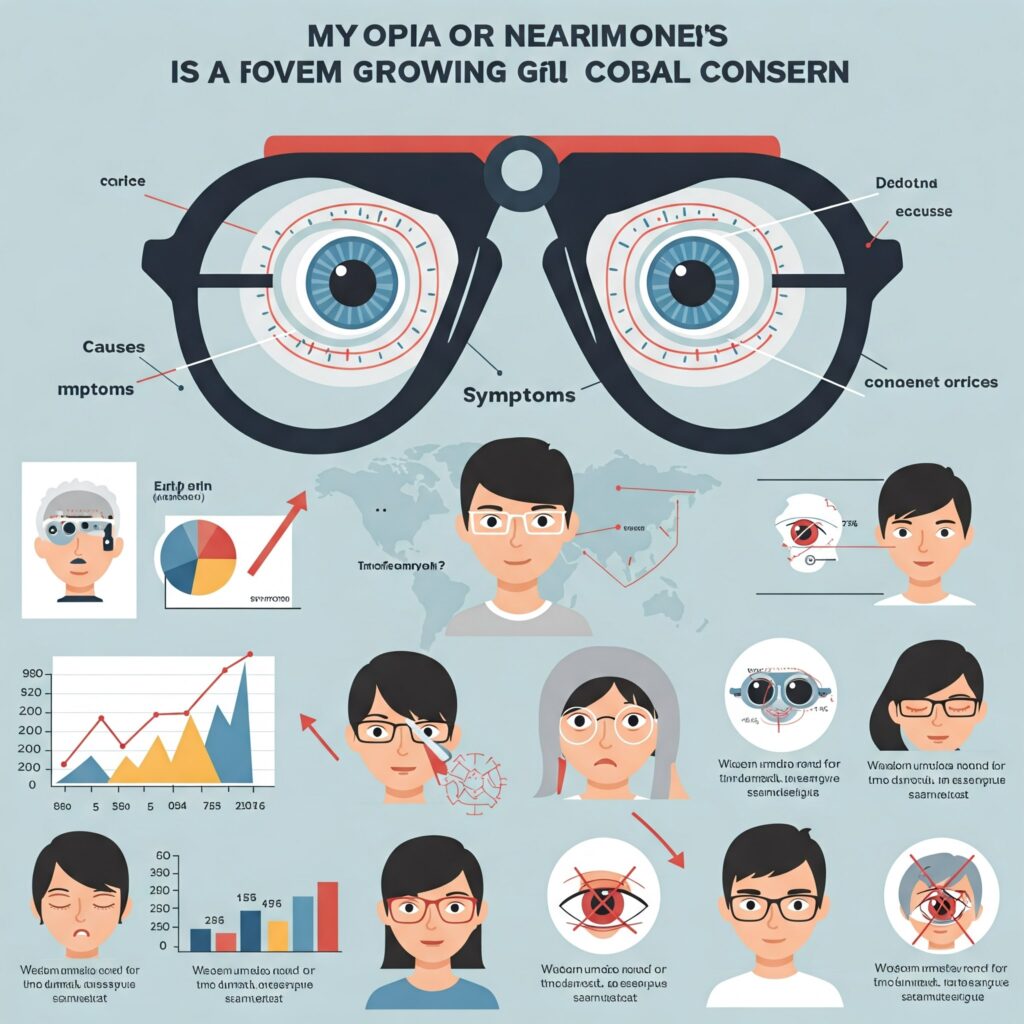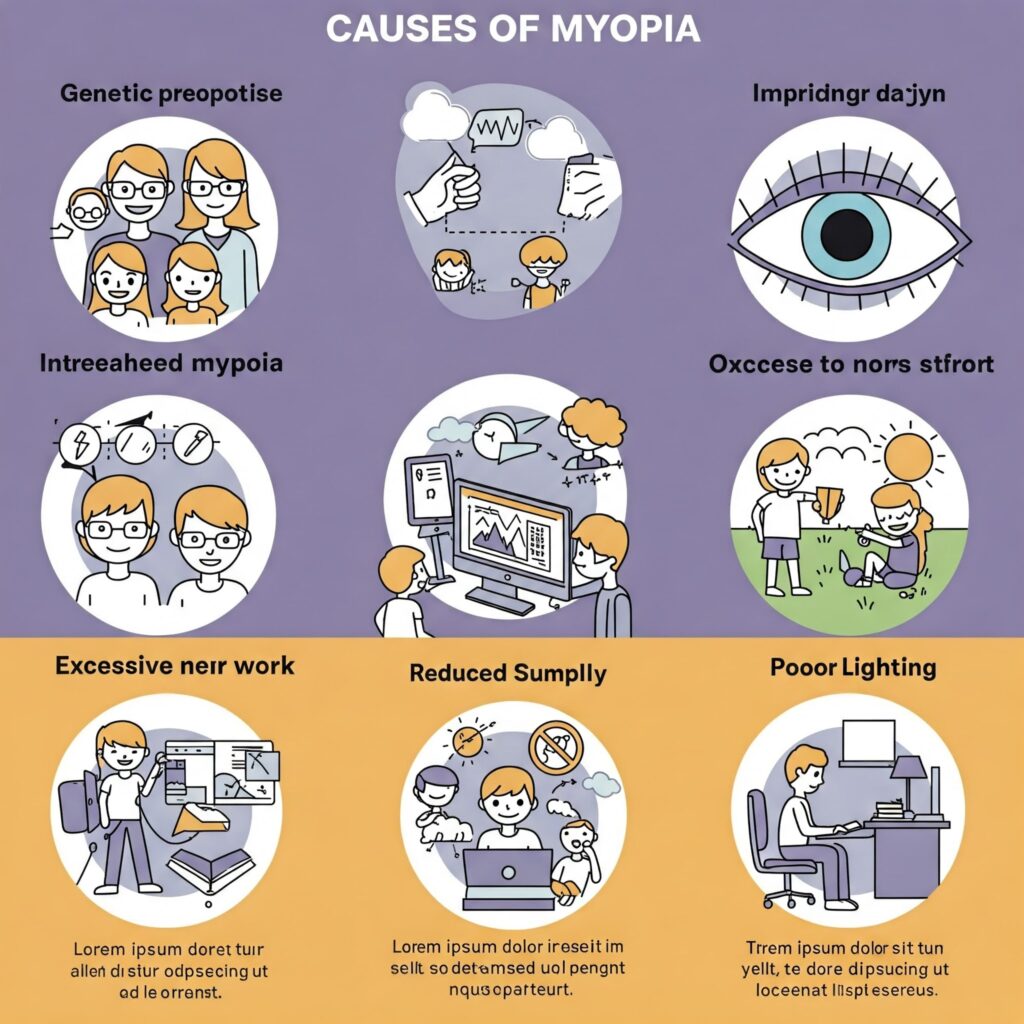Myopia, or nearsightedness, is a growing global concern. It’s not just a matter of needing glasses anymore. In fact, nearsightness is rapidly becoming one of the leading causes of vision impairment worldwide. With screen time increasing and outdoor time decreasing, the number of people affected is rising fast. But here’s the good news: nearsightness is manageable. We’ll break down what causes nearsightness and explore 14 of the best treatments available today.

What is Myopia?
It is a condition where distant objects appear blurry while close-up items remain clear. It happens when the eyeball is too long or the cornea is too curved, causing light to focus in front of the retina instead of directly on it.
Types of Myopia:
- Simple Myopia: The most common form, usually developing in childhood.
- High Myopia: A more severe form that increases the risk of serious eye problems.
- Degenerative Myopia: A rare, progressive type that can lead to blindness if untreated.
Why is Nearsightness Increasing?
Modern lifestyles play a big role. Kids spend less time outside and more time on screens. Genetics also play a part, but environmental factors are driving the surge.
Global Perspective:
Over 2 billion people globally have nearsightness, and by 2050, that number could hit 5 billion. In parts of Asia, over 80% of young adults are affected
Causes of Myopia
- Genetics: If one or both parents have nearsightness, there’s a higher chance their children will too.
- Excessive Near Work: Reading, writing, or staring at screens for long periods strains the eyes.
- Lack of Outdoor Time: Natural light and looking at distant objects outdoors help regulate eye growth.
- Poor Lighting: Reading in dim light can contribute to eye strain.
- Improper Posture: Bad posture during reading or screen use affects visual development.
- Diet Deficiency: Lack of nutrients like vitamin A can influence eye health.
- Underlying Health Conditions: Diabetes and other systemic conditions can lead to vision changes.
- Myth-Busting: Reading in the dark doesn’t directly cause nearsightness, but it can worsen strain that contributes to it

14 Best Treatments for Myopia
- Prescription Eyeglasses
- Most common and accessible treatment.
- Offers immediate correction.
- Doesn’t stop progression but improves quality of life.
- Contact Lenses
- Great for those who prefer not to wear glasses.
- Comes in daily, weekly, or monthly options.
- Requires proper hygiene to avoid infections.
- Orthokeratology (Ortho-K)
- Special rigid lenses worn overnight.
- Temporarily reshape the cornea.
- Can slow nearsightness progression, especially in children.
- Low-Dose Atropine Eye Drops
- Used to slow the progression of myopia in children.
- Requires ongoing use under doctor supervision.
- Laser Eye Surgery (LASIK, PRK, SMILE)
- Reshapes the cornea permanently.
- Best for adults with stable prescriptions.
- High success rate but carries risks.

- Implantable Contact Lenses (ICL)
- Surgically placed inside the eye.
- Option for those who aren’t LASIK candidates.
- Refractive Lens Exchange (RLE)
- Removes natural lens and replaces it with an artificial one.
- Typically used in older adults or those with high-myopic.
- Specialized Defocus Glasses
- Lenses specifically designed to reduce strain and slow progression.
- Often used in children.
- Multifocal Contact Lenses
- Provide different levels of focus for distance and near vision.
- Can help control nearsightness progression.
- Lifestyle Changes
- 20-20-20 rule: every 20 minutes, look at something 20 feet away for 20 seconds.
- Increase outdoor activity.
- Blue Light Filtering
- Glasses or screen filters that reduce digital eye strain.
- Helpful but not a direct treatment.
- Nutrition
- Diets rich in vitamins A, C, E, and zinc support eye health.
- Omega-3 fatty acids are beneficial too.
- Vision Therapy
- Custom eye exercises prescribed by an optometrist.
- Improves focus and eye coordination.
- Emerging Treatments
- Research into gene therapy and AI diagnostics.
- Still in early stages but promising for future control.

Living with Myopic
Living with myopic condition means making smart choices daily. Regular check-ups, protective eyewear, and good habits can prevent it from worsening. Students should set up good lighting, take screen breaks, and avoid holding reading material too close. Adults should balance screen time with outdoor breaks and get eye exams annually.
Preventing Nearsightness in Kids
- Encourage at least 2 hours of outdoor play daily.
- Limit screen time.
- Ensure proper lighting when reading or studying.
- Look out for signs like squinting or sitting too close to screens.
- Schedule eye exams annually starting at age 3.
Myopic patients doesn’t have to take over your life. Whether it’s glasses, contacts, or emerging treatments, there are many ways to manage it. The key is early action. Stay informed, get regular eye checkups, and don’t ignore the symptoms. With the right care, this is manageable—and in many cases, preventable.
Stay sharp, and take care of your vision.
What is the highest myopia?
High myopia typically refers to -6.00 diopters or more. Extremely high myopia can go beyond -10.00, increasing the risk of serious eye conditions like retinal detachment.
Myopia lens
Myopia lenses are concave (minus-powered) lenses that help focus light correctly onto the retina, making distant objects clearer.
Myopia treatment
nearsightness can be treated with glasses, contact lenses, Ortho-K, atropine drops, laser surgery, and emerging technologies. The best option depends on age, severity, and lifestyle.
Myopia causes
nearsightness is caused by a combination of genetics and environmental factors, such as excessive screen time, lack of outdoor activity, and prolonged near work.
Myopia symptoms
Blurred distance vision, squinting, eye strain, headaches, and needing to sit close to screens or books are common symptoms of myopia.
Myopia and hypermetropia
Myopia (nearsightedness) makes distant objects blurry. Hypermetropia (farsightedness) makes close-up objects blurry. They are opposite refractive errors.
Myopia correction
Correction methods include prescription glasses, contact lenses, laser surgery (LASIK, SMILE), and specialty lenses like Ortho-K or multifocal lenses.
Can myopia be cured?
Myopia cannot be fully cured, but it can be corrected and managed effectively. Some treatments may slow or halt its progression, especially in children.
